Back To The Future – The Game: Episodes 3, 4, and 5 – Review
by Edward
|
 When it comes to a good story I’ve never been the most patient person. I lost count of how many nights in my childhood I was told off for staying up well past my bedtime, reading literary classics like The Hitchhiker’s Guide to the Galaxy or Tolkien’s The Hobbit (it had a dragon, therefore my mind remembers it as a classic). Even as gaming became a more prevalent past-time, I never lost my lust for an entertaining story, and it’s probably one of the reasons I was most attracted to the point and click genre. After all, many point and click games live or die on the quality of their story and their humour and, while many can’t hope to match the bar set by Adam’s Sci-Fi Quintology, they can still have me staying up until the early hours of the morning to see the story through to the end.
When it comes to a good story I’ve never been the most patient person. I lost count of how many nights in my childhood I was told off for staying up well past my bedtime, reading literary classics like The Hitchhiker’s Guide to the Galaxy or Tolkien’s The Hobbit (it had a dragon, therefore my mind remembers it as a classic). Even as gaming became a more prevalent past-time, I never lost my lust for an entertaining story, and it’s probably one of the reasons I was most attracted to the point and click genre. After all, many point and click games live or die on the quality of their story and their humour and, while many can’t hope to match the bar set by Adam’s Sci-Fi Quintology, they can still have me staying up until the early hours of the morning to see the story through to the end.
Herein lies my biggest problem with episodic gaming: I get incredibly impatient waiting for an email telling me that the next instalment in the series is now available, twitch as the download bar slowly fills, and start rocking back and forth as the game installs. While I’ve gradually trained myself to overcome this, Back to the Future – The Game dashed all hopes of recovery. After reviewing the first two episodes earlier this year, I got so impatient waiting for the end of the story that I made some modifications to the time machine I use to review games from the future so I could finish the end of the series without the wait. I should have taken some cues from the adventures of Marty and Doc Brown, because it’d be an understatement to claim that it didn’t go very well.
I don’t want to divulge too much information about what happened, and I’m not going to pressure you, but if you don’t read this review you may disrupt the space-time continuum and fade out of existence. Just saying.
The third episode begins with Marty literally crash landing back into his present, only to discover that his actions in the past have caused Hill Valley to turn into an Orwellian nightmare. That’s not all, as the DeLorean’s trashed, Doc’s disappeared, and Marty’s girlfriend has turned into a punk rock chick. While the first two episodes had the difficult task of having to appeal to fans of the franchise and ease in newcomers to the genre, the latter three episodes have to keep potential players engaged with the story and encourage them to see it through to the end. However, Episode Three makes it look all too easy as it hooks the player into the story and provides an amazing experience, despite confining the player to the alternative 1986 Hill Valley the entire time.
One of the most appealing aspects of the Back to the Future franchise comes from the wide variety of distinctly defined characters, and one of the highlights of Episode Three stems from the ability to see how many favourites have been impacted in the light of your meddling throughout time. You can’t make a time-travelling omelette without breaking a time-line of eggs, and it’s fascinating to see how Telltale handle the alternative-present version of Hill Valley’s famous residents, and you’ll really appreciate how well-woven these consequences are into the events of Citizen Brown.
 As you make your way through the episode you’ll begin to notice that the humour relies less on referencing the films to generate its laughs and allows the story to become the focus of the gameplay. The shift of focus from the humour to the story gives the episode a more balanced feel in terms of the gaming experience, as well as giving those comic moments more impact when they arrive. One of the best moments of the episodes came about halfway through, with a confrontation between George and Lorraine McFly; it felt amazingly fresh, showed a great dynamic between the characters and left me laughing so much I didn’t even feel actively aware I was solving a puzzle.
As you make your way through the episode you’ll begin to notice that the humour relies less on referencing the films to generate its laughs and allows the story to become the focus of the gameplay. The shift of focus from the humour to the story gives the episode a more balanced feel in terms of the gaming experience, as well as giving those comic moments more impact when they arrive. One of the best moments of the episodes came about halfway through, with a confrontation between George and Lorraine McFly; it felt amazingly fresh, showed a great dynamic between the characters and left me laughing so much I didn’t even feel actively aware I was solving a puzzle.
However, my favourite part of Citizen Brown wasn’t a particular puzzle, or even the story, but Hill Valley itself. The alternative version of the town has a beautiful, rich art style, and is such a beauty to explore thanks to the inhabitants. It may be optional to investigate displays and discover how much the famous town has changed, but doing so reveals just how much love and attention Telltale put into its creation. Later episodes are full of heartbreaking moments, but one of the most devastating for me was having to leave Citizen Brown’s vision of Hill Valley at the beginning of the fourth episode, as it became a character in its own right, and one which I couldn’t bear to see go.
Episode Three may be a great experience, but that doesn’t mean it’s without flaw, though these will do little to detract from your experience. As I was playing through I noticed how much the inventory takes a back-seat to puzzle-solving, with any items you’ve been carrying in previous episodes being completely useless here. Puzzles also begin to rely slightly on guesswork, and there’ll be an instance or two where you’ll have to repeat a puzzle because of a factor you couldn’t possibly have thought of until it occurs. Then there’s the noticeable lack of a key character; despite their titular billing, Citizen Brown is relegated to only a few scenes, and his presence in the episode feels all too brief.
 |
 |
 |
 |
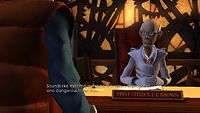 |
 |
In fact, if there’s a single word to describe Episode Three, it’s ‘brief’. Despite being forced to repeat several puzzles and choosing to explore Hill Valley as much as I could, I became acutely aware of how little time I’d spent playing the episode as soon as “To Be Continued” slammed onto my screen. It may be down to the fact that the end-pacing suggests there’ll be more than what actually occurs, or the fact that the climactic puzzle feels much tamer in comparison to the epic finales of previous episodes. Maybe it’s just the fact that I wish there was more to do before the cliffhanger that is best described as “evil”, so much does it strong-arm you into needing to play the next instalment. In terms of a mid-series chapter, Citizen Brown is well crafted, and a great way to explore the impact of your actions thus far in the story; it does an amazing job of building you up for what comes next I was incredibly disappointed by how much the following episode botched it up.
Wait, what?
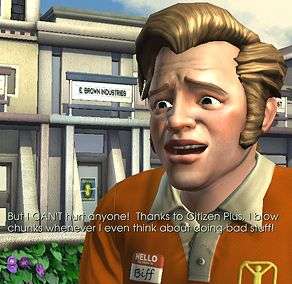 Spoiling as little as possible, the opening of Double Visions tasks you with getting the hell out of Dodge (or, in this case, the nightmare utopia of 1986 Hill Valley) with Citizen Brown in tow, in order to go back to 1931 and fix the issues your meddling in the past has caused. Sadly, things go wrong from the outset, and this sets up the episode’s theme of being given a task and little to no indication of how to complete it. Cue plenty of artificial experimentation and genuine frustration as you’ll be forced to complete the first series of tasks with some pixel hunting and little indication of what you’re actually supposed to do – something that doesn’t change much throughout the rest of the episode. Of course, this is where the hint system comes in useful, but even if I view it as a sign of defeat, if I actually have no idea how I’m supposed to complete a puzzle or set the next series of events into motion, then one of the sides between player and creator is flawed.
Spoiling as little as possible, the opening of Double Visions tasks you with getting the hell out of Dodge (or, in this case, the nightmare utopia of 1986 Hill Valley) with Citizen Brown in tow, in order to go back to 1931 and fix the issues your meddling in the past has caused. Sadly, things go wrong from the outset, and this sets up the episode’s theme of being given a task and little to no indication of how to complete it. Cue plenty of artificial experimentation and genuine frustration as you’ll be forced to complete the first series of tasks with some pixel hunting and little indication of what you’re actually supposed to do – something that doesn’t change much throughout the rest of the episode. Of course, this is where the hint system comes in useful, but even if I view it as a sign of defeat, if I actually have no idea how I’m supposed to complete a puzzle or set the next series of events into motion, then one of the sides between player and creator is flawed.
I’m willing to throw my arms up and admit I’m probably at fault the first time this happens, and I’ll be questioning my own judgement the second time it happens. It’s when I’m forced to acquire items before being told I need them (and I’m prevented from progressing until I do so) and gain another plot-necessary item completely by accident that I’m pretty sure it’s “Designer Logic” rearing its ugly head. For the uninitiated, “Designer Logic” was the scourge of many nineties-era point and click games, as the player would find themselves stuck on a puzzle that depended more on your ability to read the demented minds of the game’s designers than approach it with any rationale or logic of your own. Unfortunately, this also has the result of being incredibly frustrating and ruinous to your enjoyment of the episode. It’s so jarring and happens so often that, in a series filled with episodes that can stand proud in the point and click genre, Double Visions is the one who showed up drunk, tried it on with your girlfriend, then promptly threw up and passed out.
There’s a puzzle later on which best describes the frustration you’ll be forced to suffer: you need to manipulate someone’s mood using four different items in the room, despite the fact there are only two reactions you can cause. You have to do – and watch – the same repetitive animations five or six times, and if you get a single part wrong you have to do it all over again. Oh, and it’s entirely possible to accidentally click towards the exit rather than to the next part of the puzzle and have to start from the beginning. Have fun!
It makes no sense to me that Telltale Games can make themselves look so amateur in spite of their pedigree. It’s such a shame, because as you make your way through the episode you can see how much care and attention went into the story, as well as the development of several important character arcs, but it seems like none of that love went into the puzzles. On the one hand, Double Visions sets the story up for an unpredictable finale, complete with a cliffhanger which keeps its cards close to the chest in preparation for the final round. Then there’s the below-average, mind-numbing puzzle design which sabotages the carefully constructed pacing and leaves you feeling rather deflated as you slog your way through the episode, and it’s this side of the experience which causes Double Visions to be the worst episode in a magnificent series.
With “Citizen Brown” and “Double Visions” out of the way, the Gaminglives DeLorean (oh, you didn’t know we have a DeLorean? I did, it’s awesome) materialises at “OUTATIME” – Telltale Games’ most satisfying season finale to date.
At the risk of gushing, everything about Episode Five is brilliant. It has an amazingly satisfying start in comparison to the previous episode, despite the slower pace and the relative lack of puzzles. The quality of the puzzles that do show up throughout the episode are vastly improved, and I’d dare say they have the best balance of difficulty and presence in the series. They don’t rely on insane or ridiculous logic and they all fit in without becoming too dominant or disruptive to the pace of the game. They’re still a challenge at times, but the process of solving them is far more gratifying.
Early on there’s a puzzle that’s difficult to get through, not because of its solution, but because of what you have to witness in order to solve it. You’ll know which one it is when it happens, but it’s heartbreaking to watch and consider the implications of, but it’s a brilliant moment in the season as it perfectly meshes the story and gameplay in a way I’ve seldom witnessed in a point and click. Another amazing moment comes late in the game when Marty has to restore someone’s memories; the solution is challenging but not to the point of frustration, it blends in effortlessly with the story and forces you to think about the implications of your actions just a little bit more.
The pacing of the episode is fantastically manufactured, as it manages to slowly build up throughout, leading to some effective crescendo events and helping the story deliver a greater impact as a result. In terms of the story and how it ends in this final chapter: wow. ![]()
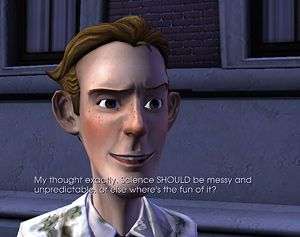 The ending of “OUTATIME” alone cements it as my favourite Telltale season finale; it manages to answer important questions, provide resolutions and wrap everything up effectively, as well as punctuate the episode with several amazing heartbreaking and heart-warming moments. Going back to one I described earlier, after its heartbreaking completion, the game moved straight into a truly heart-warming moment, then managed to slide to another heartbreaking one and back again, all within the same ten minutes. I describe Telltale Games as masters of storytelling in games, and this episode feels like the ultimate example of that; there are so many twists and turns before your adventure is over, and when you get there you won’t believe what you’ve just seen.
The ending of “OUTATIME” alone cements it as my favourite Telltale season finale; it manages to answer important questions, provide resolutions and wrap everything up effectively, as well as punctuate the episode with several amazing heartbreaking and heart-warming moments. Going back to one I described earlier, after its heartbreaking completion, the game moved straight into a truly heart-warming moment, then managed to slide to another heartbreaking one and back again, all within the same ten minutes. I describe Telltale Games as masters of storytelling in games, and this episode feels like the ultimate example of that; there are so many twists and turns before your adventure is over, and when you get there you won’t believe what you’ve just seen.
Throughout your adventure, it’ll be hard to ignore the distinctive art style that breathes that little bit of extra life into the game. The third episode is the greatest example of the amazing visuals; the dystopia that is Citizen Brown’s Hill Valley stands out as such a contrast to the rest of the game’s locations and, despite the shorter amount of time you spend there in comparison to the Hill Valley of 1931, it has the greatest impact of all the locales. There are several locations in the finale that are also of note, especially the main area you spent the first half of the game in, which manages to blend several styles without issue and combine them into the story without it becoming jarring to the player. Luckily, it can run on high settings, even on a low end laptop like mine, and I was able to run the game at its full graphical settings with no problems whatsoever. Visually, Back to the Future is Telltale Game’s greatest achievement, even if it isn’t their most distinctive.
In the review of the first two episodes, I mentioned the stellar voice-acting and how much it improves the experience; A.J Locascio does an amazing job as Marty McFly, James Arnold Taylor puts in an incredible performance as the young Emmett Brown and Christopher Lloyd as both Citizen and Doc Brown help provide some of the best voice-acting in anything by Telltale Games. These later episodes manage to up the ante with the return of a couple of cast members and some even better performances by the aforementioned voice actors. The first return comes in the form of Claudia Wells, who reprises her role as Jennifer Parker for the first time since the first Back to the Future film, and she does a great job of making the rebellious version of Jennifer more audibly distinctive than in her previous outing, giving a refreshing new look at the character. The appearance of Michael J. Fox in the final episode comes as one of the bigger surprises, appearing in a couple of small but vital roles. His appearances left me with a massive smile on my face, as it felt like he was passing the torch in any scenes between himself and A.J Locascio’s Marty. Throughout all three episodes, the voice acting is nothing short of incredible, and the season contains some of the greatest examples I’ve ever heard in a videogame.
That voice-acting and the entire game itself would fall flat if it wasn’t backed up with truly incredible writing. From exploring a Hill Valley ruled by Citizen Brown to the shock revelations of the finale, the writing will keep you engrossed from beginning to end. Nearly everyone you meet is brilliantly written, and the new personalities you’ll come across become so important that you’ll be sad to see them go. It provides the greatest incentives to explore in episode three, it manages to take some interesting turns in episode four and provide fun – despite the counter-intuitive puzzle design – and it manages to constantly tug at the heart-strings and keep the player guessing in the finale.
 |
 |
 |
 |
 |
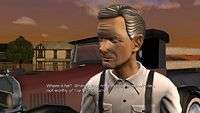 |
Even though the humour takes less focus than it does in the first two episodes, there’s still enough of it that there were several moments where I found it nearly impossible to resist laughing, and the episodes are so charming that the writing kept a smile on my face throughout the vast majority of my time playing. There really was no way to predict how the premise would play out, and the episodic nature of the game helped this even more, as I was left pondering everything after each episode, trying to figure everything out and predict what was coming next. Now all the episodes are out, some of that impact is sadly gone, but it doesn’t mean that the twists, events and outcomes are less effective, even in retrospect. From the smallest joke to the biggest plot-line, it really feel like there was no line wasted, no performance under-utilised, and it all comes together expertly. If you’ve ever enjoyed point and click games or the Back to the Future films it should be a legal requirement to complete this game.
Pros- Hill Valley under the guidance of Citizen Brown is a joy to behold and explore
- Even though the humour is less dominant, it's still spot-on and can't fail to put a smile on your face
- Art style that impresses, even on a lower-spec laptop
- When the puzzles hit, they're well crafted and fit in brilliantly with the story
- The episodes explore some great concepts
- Pretty much the entirety of "OUTATIME"
- Some of the greatest voice acting I've ever heard in a videogame
- The writing is leaps and bounds above the majority of games
- The best season Telltale Games have created
- You'll never see the ending coming
- When the puzzles miss, they're frustrating and rely on guesswork, experimentation and "Designer Logic"
- Crescendo events can be a little weak
- "Citizen Brown" feels too short
- "Double Visions" lacks in quality when compared to the previous episode and the finale
- I can't play it for the first time again
In terms of individual episodes, both "Citizen Brown" and "OUTATIME" are fantastically made adventures, especially in comparison to the confusingly weak fourth episode. Each episode can be beaten within an afternoon, and as a season of episodic instalments it creates some great, distinctive chapters complete with cliffhangers that'll leave you clamouring for more, but when you put it all together it's like being hit with 1.21 Gigawatts of pure awesome.
There's so many ways a game based on Back to the Future could have gone horribly wrong, but somehow Telltale Games have managed to not just pay fantastic tribute to the series, but they've provided an adventure that's such a joy to play that it stands proud alongside the films as a vital addition to the franchise. It's an incredibly well-made experience that manages to be one of the best point and click adventures for a long while, and something I'd be proud to consider one of my games of 2011.
Last five articles by Edward
- Best of 2015: Journey's End: A New Beginning
- Journey's End: A New Beginning
- You Can't Choose Your Happy Ending
- Okay, Let's Fix Comedy In Games - The V-Effekt
- Time Keeps On Smashing Away
















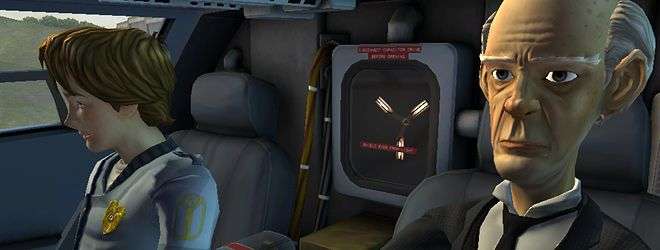







haha like the tags, Read my fax YOU’RE FIRED. I’ll probably get this soon or might ask for it for xmas.
I have an imeasurable amount of love for the film trilogy, and so I’ve had the games ont eh back burner for a while now, meaning to get around to them. While I am not so keen on episodic gaming, now that they are all out, there is simply no excuse anymore. I think I’ll be saving these for the Christmas period, when I can relax and finally blast through everything that I should have played this year.
The voice acting is a huge draw for me, and while it is sad that Michael J. Fox wasn’t voicing Marty throughout, I’m at least glad that he finally makes an appearance. Well written review, very passionate, and sells the game well, nice one
I dunno if I’d play this, to be honest. If I had to choose between this and Jurassic Park, I’d likely go for this because I have more love for the franchise than I do Jurassic Park, and it’s a more interesting art style. It’d certainly be interesting to keep the story going though, and I DO want to spend more time with the adventure genre if I can.
We’ll see… it may yet happen. If only we could see into the future.